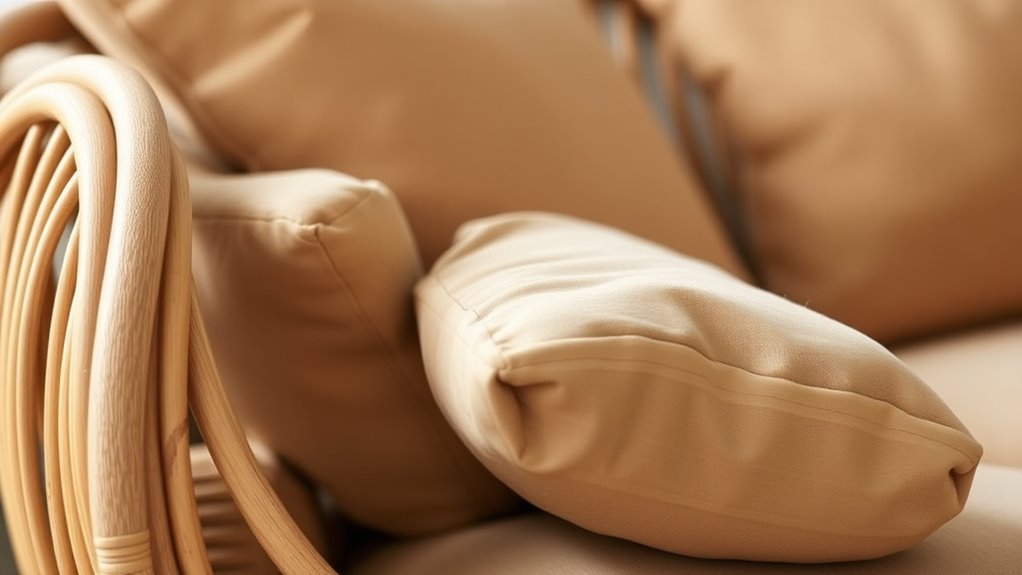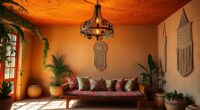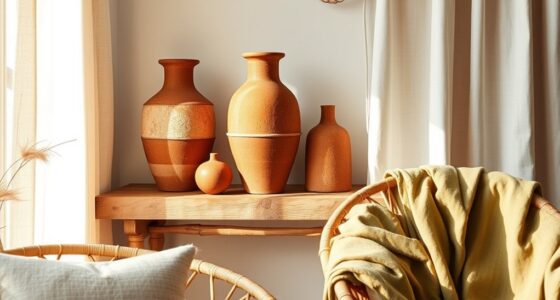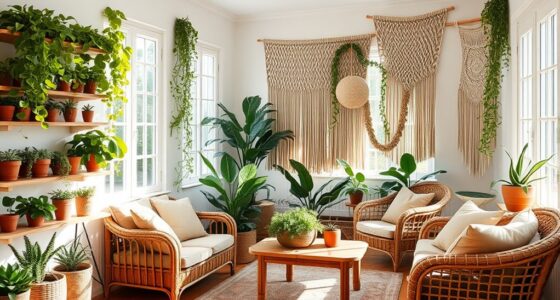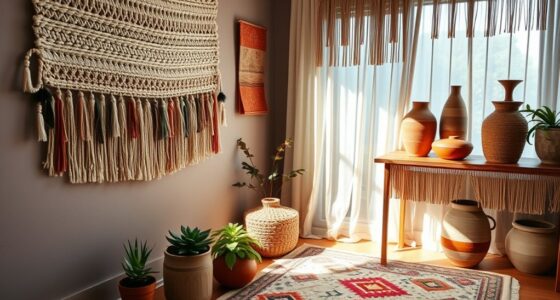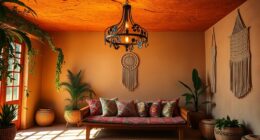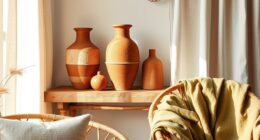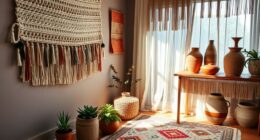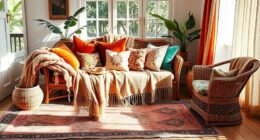To incorporate curves and organic shapes into boho furniture, focus on pieces with rounded edges, flowing silhouettes, and irregular forms made from natural materials like rattan, wicker, or reclaimed wood. Choose curved sofas, arched headboards, and circular mirrors to emphasize organic flow. Bright, tribal-patterned cushions and handwoven rugs add pops of color that complement the shapes. With the right mix of textures and forms, you’ll create a cozy, relaxed space that embodies boho elegance—learn more to perfect your style.
Key Takeaways
- Select furniture with rounded edges and flowing silhouettes, such as curved sofas and arched headboards, to emphasize organic forms.
- Use natural materials like rattan, wicker, and reclaimed wood that feature irregular, flowing shapes inspired by nature.
- Incorporate circular mirrors, rounded tables, and asymmetrical arrangements to enhance the organic aesthetic.
- Add colorful cushions and handwoven rugs with lively, organic patterns to create visual interest and vibrancy.
- Use lighting fixtures with curved bases or woven pendant designs to highlight the natural shapes and textures of boho furniture.
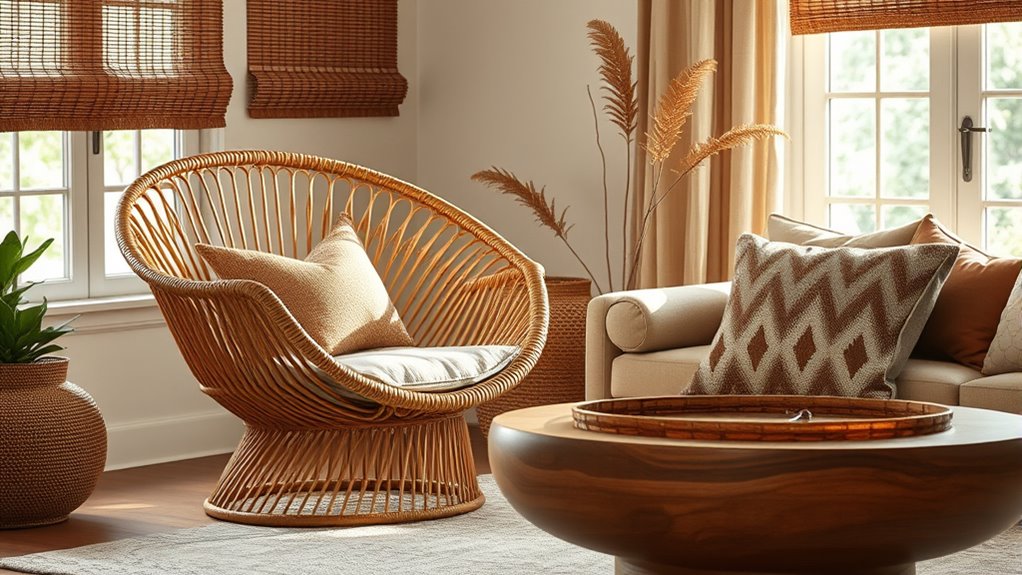
If you’re looking to elevate your boho interior, incorporating curves and organic shapes is an effortless way to add visual interest and a sense of natural flow. These design elements soften sharp lines and create a more inviting, relaxed atmosphere. To truly embrace the boho vibe, focus on natural materials like rattan, wicker, bamboo, and reclaimed wood. These materials inherently feature flowing, irregular shapes that mimic nature’s organic forms. Whether it’s a rounded rattan armchair or a curvy wooden coffee table, using natural materials enhances the authenticity of your space while offering tactile richness. Incorporating natural materials in your furniture and decor emphasizes wood, stone, and linen, which are key elements in creating a harmonious, organic aesthetic. Colorful accents play an essential role in complementing these shapes, injecting vibrancy and personality into your décor. Think of cushions with bold, tribal patterns, handwoven rugs with lively hues, or decorative ceramics in striking colors. These accents don’t just add visual pop; they also highlight the organic shapes by drawing attention to their curves and irregularities. For example, a brightly colored, curved ceramic vase can serve as a focal point on a natural wooden side table, emphasizing the fluidity of the design. Combining colorful accents with organic forms creates a lively, eclectic atmosphere that’s quintessentially boho. When choosing furniture, opt for pieces that feature rounded edges and flowing silhouettes. A sofa with curved arms, a rounded lounge chair, or a bed with a softly arched headboard can seamlessly introduce organic shapes into your space. Mix these with accessories like curved mirrors or circular wall art to reinforce the theme. Remember, the key is to keep the overall look relaxed, so don’t be afraid to combine different shapes and sizes. An asymmetrical arrangement of natural material furniture pieces, paired with vibrant textiles, creates a dynamic yet harmonious environment. Lighting also plays an essential role in highlighting organic shapes. Use lamps with curved bases or woven pendant lights that cast warm, inviting glows. The interplay of light and shadow can accentuate the natural curves, making your space feel more lively and inviting. When you blend natural materials with colorful accents and curved furniture, you craft a space that feels both grounded and spirited—perfect for a boho aesthetic. This approach invites you to embrace imperfection and celebrate the beauty of organic forms, making your home a true reflection of relaxed, nature-inspired style.
Frequently Asked Questions
How Do Curves Affect the Durability of Boho Furniture?
Curves generally enhance boho furniture’s structural integrity by improving stress distribution across the piece. You’ll find that curved designs can actually increase durability because they help evenly spread weight and pressure, reducing weak points. When you incorporate organic shapes, you’re not sacrificing strength; instead, you’re creating furniture that’s both stylish and resilient, ensuring it holds up over time while adding the natural, flowing aesthetic typical of boho decor.
What Materials Are Best for Creating Organic Shapes?
You should choose natural fibers like rattan, jute, or seagrass, and sustainable woods such as bamboo or reclaimed teak, to create organic shapes. These materials are flexible and easy to mold into curves, giving your boho furniture a soft, flowing look. Plus, they’re eco-friendly and durable, ensuring your pieces stay beautiful and lasting over time. Using these materials helps you craft authentic, sustainable boho designs with appealing organic forms.
Can Curved Furniture Be Easily Integrated Into Modern Decor?
You can easily integrate curved furniture into modern decor by choosing sleek pieces like a rounded sofa or organic-shaped coffee table. For example, a homeowner paired a curved, sustainable wood chair with minimalistic, neutral-toned decor, creating a balanced look. Focus on color coordination by matching the furniture’s natural hues with your room’s palette. This approach promotes sustainable design while adding soft, inviting curves that complement modern aesthetics effortlessly.
Are There Maintenance Tips Specific to Curved or Organic-Shaped Furniture?
You should follow specific maintenance tips for curved or organic-shaped furniture. Regularly dust and clean with a gentle, damp cloth to prevent dirt buildup in crevices. Use protective finishes, like sealants or wax, to shield the surface from scratches and moisture. Avoid harsh chemicals that can damage the finish. Incorporating these cleaning routines and protective finishes will keep your furniture looking beautiful and lasting longer.
How Do Curves Influence the Comfort of Boho Furniture Pieces?
Like a gentle river guiding you, curves in boho furniture enhance comfort by embracing ergonomic design, making sitting more natural and relaxing. They soften the aesthetic appeal, creating a cozy, inviting atmosphere. You’ll find that organic shapes support your body better, reducing strain. These flowing lines invite touch and linger in your space, balancing style and function effortlessly, so you feel at ease and inspired every time you sit or lounge.
Conclusion
By embracing curves and organic shapes, you create boho furniture that feels warm, inviting, and uniquely yours. These design elements evoke a sense of nature and free-spiritedness that truly define boho style. Did you know that 78% of homeowners report feeling more relaxed in spaces with rounded furniture? So, go ahead—incorporate these soft, flowing lines into your decor and transform your space into a calming, artistic haven that reflects your personality.
